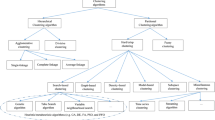Abstract
Clustering is an unsupervised classification method in the field of data mining. Many population based evolutionary and swarm intelligence optimization methods are proposed to optimize clustering solutions globally based on a single selected objective function which lead to produce a single best solution. In this sense, optimized solution is biased towards a single objective, hence it is not equally well to the data set having clusters of different geometrical properties. Thus, clustering having multiple objectives should be naturally optimized through multiobjective optimization methods for capturing different properties of the data set. To achieve this clustering goal, many multiobjective population based optimization methods, e.g., multiobjective genetic algorithm, mutiobjective particle swarm optimization (MOPSO), are proposed to obtain diverse tradeoff solutions in the pareto-front. As single directional diversity mechanism in particle swarm optimization converges prematurely to local optima, this paper presents a two-stage diversity mechanism in MOPSO to improve its exploratory capabilities by incorporating crossover operator of the genetic algorithm. External archive is used to store non-dominated solutions, which is further utilized to find one best solution having highest F-measure value at the end of the run. Two conceptually orthogonal internal measures SSE and connectedness are used to estimate the clustering quality. Results demonstrate effectiveness of the proposed method over its competitors MOPSO, non-dominated sorting genetic algorithm, and multiobjective artificial bee colony on seven real data sets from UCI machine learning repository.



Similar content being viewed by others
References
Akbari R, Hedayatzadeh R, Ziarati K, Hassanizadeh B (2012) A multi-objective artificial bee colony algorithm. Swarm Evol Comput 2:39–52
Bezdek J (1981) Pattern Recognition with Fuzzy Objective Function Algorithms. Plenum Press
Branke J, Mostaghim S (2006) About selecting the personal best in multi-objective particle swarm optimization. In: Parallel problem solving from nature-PPSN IX, Springer, pp 523–532
Coello CAC, Pulido GT, Lechuga MS (2004) Handling multiple objectives with particle swarm optimization. Evol Comput IEEE Trans 8(3):256–279
Corne DW, Jerram NR, Knowles JD, Oates MJ, et al. (2001) Pesa-ii: Region-based selection in evolutionary multiobjective optimization. In: Proceedings of the genetic and evolutionary computation conference (GECCO2001)
Das S, Abraham A, Konar A (2008) Automatic clustering using an improved differential evolution algorithm. Syst Man Cybern Part A Syst Humans IEEE Trans 38(1):218–237
Deb K (2001) Multi-objective optimization using evolutionary algorithms. Wiley-interscience series in systems and optimization. Wiley
Deb K, Jain S (2002) Running performance metrics for evolutionary multi-objective optimizations. In: Proceedings of the fourth Asia-pacific conference on simulated evolution and learning (SEAL’02),(Singapore), pp 13–20
Deb K, Agrawal S, Pratap A, Meyarivan T (2000) A fast elitist non-dominated sorting genetic algorithm for multi-objective optimization: Nsga-ii. Lect Comput Sci 1917:849–858
Ehrgott M (2005) Multicriteria optimization. vol 2. Springer
Esmin AA, Coelho RA, Matwin S (2013) A review on particle swarm optimization algorithm and its variants to clustering high-dimensional data. Artificial Intelligence Review, pp 1–23
Ester M, Kriegel HP, Sander J, Xu X (1996) A density-based algorithm for discovering clusters in large spatial databases with noise. KDD 96:226–231
Faceli K, Sakata TC, de Souto MC, de Carvalho AC (2010) Partitions selection strategy for set of clustering solutions. Neurocomputing 73(1618):2809–2819
Handl J, Knowles J (2004) Evolutionary multiobjective clustering. In: Parallel problem solving from nature-PPSN VIII, Springer, pp 1081–1091
Handl J, Knowles J (2007) An evolutionary approach to multiobjective clustering. Evol Comput IEEE Trans 11(1):56–76
Handl J, Knowles J (2012) Clustering criteria in multiobjective data clustering. In: Parallel problem solving from nature-PPSN XII, Springer, pp 32–41
Hruschka ER, Campello RJGB, Freitas AA, De Carvalho APLF (2009) A survey of evolutionary algorithms for clustering. Syst Man Cybern Part C Appl Rev IEEE Trans 39(2):133–155
Jain AK, Dubes RC (1988) Algorithms for clustering data. Prentice-Hall Inc
Karaboga D (2005) An idea based on honey bee swarm for numerical optimization. Techn Rep TR06, Erciyes Univ Press, Erciyes
Karaboga D, Basturk B (2007) A powerful and efficient algorithm for numerical function optimization: artificial bee colony (abc) algorithm. J Global Optim 39(3):459–471
Kennedy J, Eberhart R et al (1995) Particle swarm optimization. In: Proceedings of IEEE international conference on neural networks, Perth, Australia 4:1942–1948
Knowles JD, Corne DW (2000) Approximating the nondominated front using the pareto archived evolution strategy. Evol Comput 8(2):149–172
Kwedlo W (2011) A clustering method combining differential evolution with the k-means algorithm. Pattern Recog Lett 32(12):1613–1621
Miettinen K (1999) Nonlinear multiobjective optimization., International series in operations research & management scienceSpringer, US
Okabe T, Jin Y, Sendhoff B (2003) A critical survey of performance indices for multi-objective optimisation. In: Evolutionary computation, 2003. CEC’03. The 2003 congress on, IEEE. vol 2. pp 878–885
Park HS, Jun CH (2009) A simple and fast algorithm for k-medoids clustering. Expert Syst Appl 36(2):3336–3341
Reyes-Sierra M, Coello CC (2006) Multi-objective particle swarm optimizers: a survey of the state-of-the-art. Int J Comput Intell Res 2(3):287–308
Saha S, Bandyopadhyay S (2013) A generalized automatic clustering algorithm in a multiobjective framework. Appl Soft Comput 13(1):89–108
Sheng W, Liu X, Fairhurst M (2008) A niching memetic algorithm for simultaneous clustering and feature selection. Knowl Data Eng IEEE Trans 20(7):868–879
Storn R, Price K (1997) Differential evolution-a simple and efficient heuristic for global optimization over continuous spaces. J Global Optim 11(4):341–359
Xu R, Wunsch D et al (2005) Survey of clustering algorithms. Neural Netw IEEE Trans 16(3):645–678
zdemir S, Attea B, Khalil n (2013) Multi-objective clustered-based routing with coverage control in wireless sensor networks. Soft Comput 17(9):1573–1584
Zhou A, Qu BY, Li H, Zhao SZ, Suganthan PN, Zhang Q (2011) Multiobjective evolutionary algorithms: a survey of the state of the art. Swarm Evol Comput 1(1):32–49
Zitzler E, Thiele L (1999) Multiobjective evolutionary algorithms: a comparative case study and the strength pareto approach. Evol Comput IEEE Trans 3(4):257–271
Zitzler E, Deb K, Thiele L (2000) Comparison of multiobjective evolutionary algorithms: empirical results. Evol Comput 8(2):173–195
Author information
Authors and Affiliations
Corresponding author
Rights and permissions
About this article
Cite this article
Prakash, J., Singh, P.K. An effective multiobjective approach for hard partitional clustering. Memetic Comp. 7, 93–104 (2015). https://doi.org/10.1007/s12293-014-0147-5
Received:
Accepted:
Published:
Issue Date:
DOI: https://doi.org/10.1007/s12293-014-0147-5




